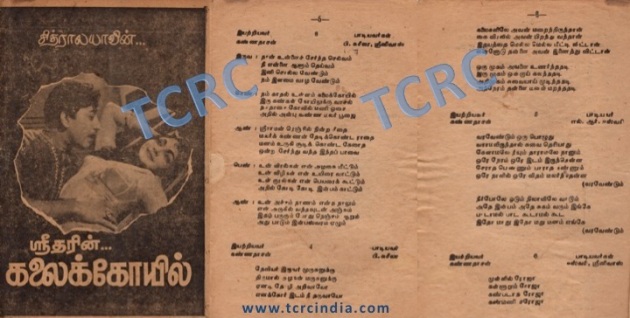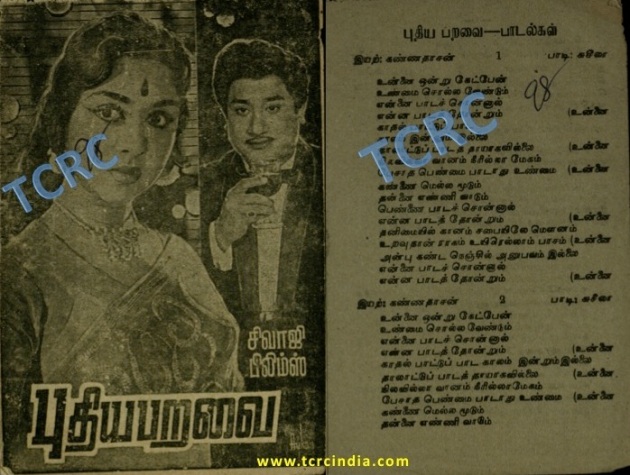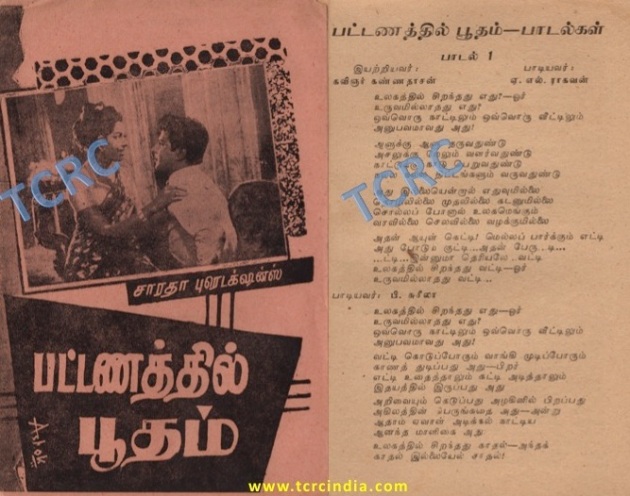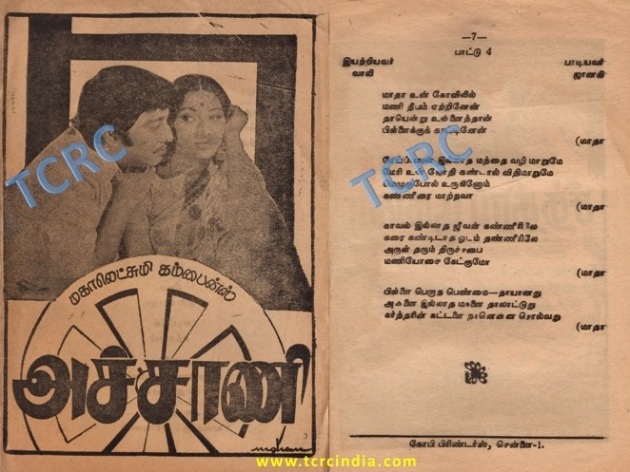By P.V. Gopalakrishnan
In this concluding part on Exotic Instruments in Film Music I wish to share some of my thoughts on our classic numbers in Tamil Film Music from the bygone era, listening to which we get transported back to relive the past!
They make us visualize the mammoth orchestra that went with the recording of many of the classic songs. This in turn trigger our thoughts on those times when these melodies were made. By any count, people mostly agree that these oldies from the world of Indian Film music are indeed a treasure. The melodies of these songs are as fresh as the morning breeze to us forever. Added to them, the fine lyrics & clear diction of the singers make them so memorable.
This writer has had, during his prime days, the opportunity of witnessing few song recordings, thanks to a peer with connections! Those days were prior to the advent of stereo. The musicians were so cramped in a small recording room. Often the instruments they played on, per se, were hugely cumbersome, whether it is Univox, Double Base, Vibraphone, Piano, Cello, Kettle Drum or Harp. The air-conditioning was mostly absent as they wanted to be free from the noise of room air-conditioners & the central cooling system was not in vogue then. Imagine these very classic melodies, that were made in such less friendly environs, are being crooned out over stereophonic mikes with mixing facilities by today’s participants of TV Reality & stage shows, in the air-conditioned comfort. Whereas those men who played this music in perfect harmony, recorded them so truly sweating them out.
Those were the days, not blessed with digital sound technology. Nor were sound files & bytes known. The recordings were done the hard way. Thanks to the non-advent of track recording, the singers were in full human form & feeling the real music emanating from physically played instruments by a swarm of musicians. This meant a lot of understanding, respect & harmony between the singers & the players. The real human side of the collective music, if you like.
The music so generated also had passion in its roots having been delivered by talented musicians in real time recording situations. These unplugged sounds of the music were pure & original from each instrument, whether wind, brass, string or percussion. These great melodies were captured by “shure” mikes of mono format & made captive in vinyl record discs of those times, in the avatar of LPs & EPs. There were no computer generated beats, no octopus pads & no synthesizers, which today form, at best, poor imitations of the reverberations of the original instruments.
Some of the legends of sixties in the Tamil film music world included doyens like Sabesan (pianist), Raju (mandolin), Henry Daniel (trumpetist), Sudarsanam (flute), Philip (guitarist), Mangalamurthy (accordian), Hanumanthayya (tabla), who were all over the immortal compositions of the duo Viswanathan – Ramamoorthy. These guys were behind each of the old time melodies & many of them have left this world since leaving a huge vacuum!
With limited medium of entertainment (TVs, other recorded devices made advent much later) all ears were glued to those radio sets listening to Radio Ceylon and these musicians lived up to the responsibility of delivering the sole audio entertainment of those days. And they did it with aplomb, in unmatched quality!
Listening to these old melodies bring you nostalgia, laced with a tint of sadness of having lost those days forever in one’s life! A sadness of a like which is as soothing as weeping!!
But, it is unfortunate that these classic film musicians did not directly see themselves in limelight & withered away unacknowledged largely, though Groups like MSV Times bring honor to some of them either live or posthumously.
Now on to discuss the individual musical instruments that played in well known songs.
Dholak is a double sided folk drum, usually played with both hands while positioned on the player’s lap while an iron thumb ring is used to produce a distinctive rim sound as rhythm.
In many old Tamil songs, one used to hear Dholak beats and here is ‘Ullathile uram vendumada’ rendered by A.M.Raja from Vijayapuri Veeran, composed by T.R.Paappa, for your listening pleasure. (1960)
The beautiful duet, ‘Anbu manam kanindha pinne’ (Aalukkoru veedu -1960 Film) too has Dholak percussion through the song.
‘Dafli’, as it is called in Hindi, is a Tambourine, denoting an instrument with a large circular drumhead, on which skin membrane is stretched over the playing area. In Tamil, it is colloquially known as ‘Tape’. In Hindi a full film called ‘Sargam’ was dedicated to it, with Rishi Kapoor as a Dafli player. Here is a popular Tamil song, ‘Ellorum kondaduvom’ by TMS from ‘Pava Mannippu’, composed by MSV-TKR.
The Western Drum Set has also been often used in Indian film music. Here is an instance of its deployment in ‘Kannirendum minna minna’ from ‘Andavan Kattalai’, rendered by P.B.Srinivas & L.R.Easwari. The composers MSV-TKR have used it along with Piano Chords through the song. Mr. Noel Grant was the ace drummer who worked in the orchestra of MSV-TKR.
Snare Drum, which is part of the main Drum Set, is played by striking it with either a drum stick or any other form of beater, including brushes which produce a softer-sounding vibration from the snare wires. Our composers have used Snare Drums in many songs. Here we can hear it in the song ‘Sugam…sugam’ from the film ‘Thangai’ (1967) composed by MSV.
Ghatam is an instrument used in carnatic stream of music & is one of the most ancient percussion instruments of South India. It is a clay pot with a narrow mouth. From where, it slants outwards to form a ridge. Made mainly in Manamadurai (Tamil Nadu) & Devanahalli (Karnataka), of clay with with brass or copper filings along with a small amount of iron filings, it’s a fixed pitched instrument. It has been made international by the Ghatam Wizard ‘Vikku’ Vinayakaram, who holds even a Grammy Award.
‘Azhagana Ratchasiye’ composed by A.R.Rahmam for the film ‘Muthalvan’ has ample usage of Ghatam. Dr.Karthick has played ghatam for A.R.Rahman in some of his compositions.
Veena is an instrument that relates to historical past, which is used in Carnatic stream. However, artistes like Chittibabu, Parthasarathi & Rajesh Vaidya have done some excellent work, playing for various composers in Tamil films.
We cite here two Tamil film melodies featuring Veena, ‘Sonna sollai nee’ by M.S. Rajeswari, from ‘PeNN’ composed by Sudarsanam & ‘Deviyar iruvar’ from ‘Kalai Koil’ composed by MSV-TKR. The latter film featured copious Veena notes in its songs as well as BGM, as the Hero was shown as a Veena artiste. These were played by the late Veteran Chittibabu, whose disciple is Rajesh Vaidya.

Song book of Kalai Koil with the page containing the song DEVIYAR IRUVAR PC: From the archives of TCRC
Gottu Vadhyam aka Chithra Veena is another traditional string instrument of great antiquity, popular with Carnatic music. This stringed instrument which resembles a Veena, is played by a slide just like a Hawaiian Guitar. Dr. Ravikiran is a well known exponent of the same. There have been few songs using this instrument. The Malayalam song ‘Senthar mizhi’ from ‘Perumazhakalam’, composed by M.Jayachandran features Gottu Vadhyam strains along with Ghatam beats, very creatively.
Piano too has been abundantly used in our films, particularly in South by MSV-TKR. MSV himself was very good at playing Piano. ‘Brindavanamum Nandakumaranum’ (Missiyamma), ‘Pattunro kaetten’ (Pasamalar), ‘Paaduvor padinaal’ (Kannan en kadhalan), Unnai onru ketpen, (Puthiya Paravai) Kannirendum minna minna (Andavan Kattalai), Ellorum nalam vazha (Enga Mama), Enna enna varthaigalo (Vennira Aadai) , Manithan enbavan (Sumai Thangi) , Kannenna Kannenna kalanguthu (Periya idathu peNN).

Song book of Vennira Aadai with the page containing the song ENNA ENNA VARTHAIGALO PC: From the archives of TCRC
‘Glockenspiel’ aka ‘bells, as is commonly referred to, is an instrument of German origin, having metal plates or tubes as ‘keys’ and are played by striking upon with hard tippled mallets, thus making it a metallophone. Our South Indian Composers have often used it in their songs, especially MSV-TKR duo. Listen to ‘Muthukkalo kangal’ (Nenjirukkumvarai) or ‘Thookkam kangalai’ (Alayamani) where this instrument makes very delectable notes.
Here is Harry Potter theme played on a Glockenspiel.
Vibraphone is a larger version of a ‘bells’ and has deep resonance of the notes produced which have a tremolo effect. The following video gives an idea of this instruments & its way of playing.
There are plenty of Tamil film songs where they have used this instrument. Here is an instance where Vibraphone has been used, the song being ‘Varathiruppano’ (Pachai Vilakku), rendered by P.Suseela in the composition of MSV-TKR.

Song book of Pachai Vilakku with the page containing the song VARATHIRUPPANO PC: From the archives of TCRC



